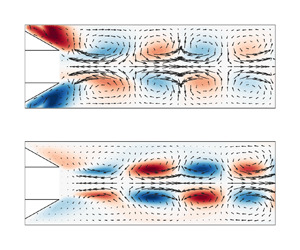No CrossRef data available.
Published online by Cambridge University Press: 05 December 2024

This paper investigates the amplification and propagation of swirl fluctuations in turbulent swirling flows using resolvent analysis. Swirl fluctuations have been repeatedly observed in acoustically excited swirl flows and play a significant role in triggering thermoacoustic instabilities in swirl-stabilized flames. While recent research on simplified rotating laminar base flows suggests that the linear inertial-wave mechanism is a key driver of swirl fluctuations, it remains unclear whether this applies to the fully turbulent regime and whether a linear method is sufficient for modelling. To address this issue, a turbulent swirling pipe flow is considered using large-eddy simulations and phase-locked particle image velocimetry, which are combined with mean-field resolvent analysis. A sound agreement between the empirical and physics-based modes is found in terms of shape and propagation velocity. The latter is particularly important for thermoacoustic time-lag models. The comparison with a generic rotating pipe flow shows that the observed swirl fluctuations are indeed driven by a linear inertial wave mechanism. The resolvent framework is, then, exploited to further investigate the coupling and amplification mechanisms in detail. It is discovered that the combined effects of inertia and strong shear lead to very high amplification rates of the swirl fluctuations, explaining the high potential of these structures to trigger combustion instabilities. The study further demonstrates the capability of the resolvent to reveal the driving mechanisms of flow response structures in highly complex turbulent flows, and it opens the path for efficient physics-based optimization to prevent combustion instabilities.